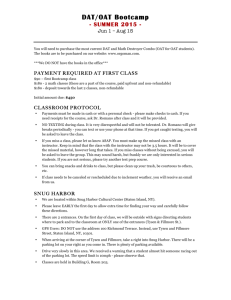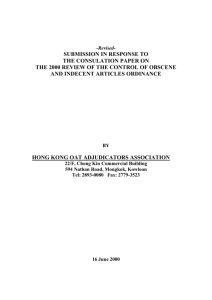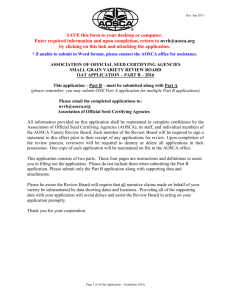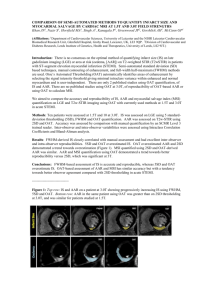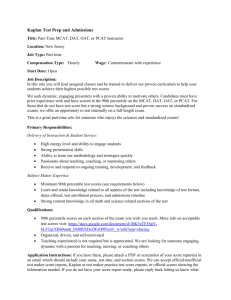ADA.org: OAT FAQ
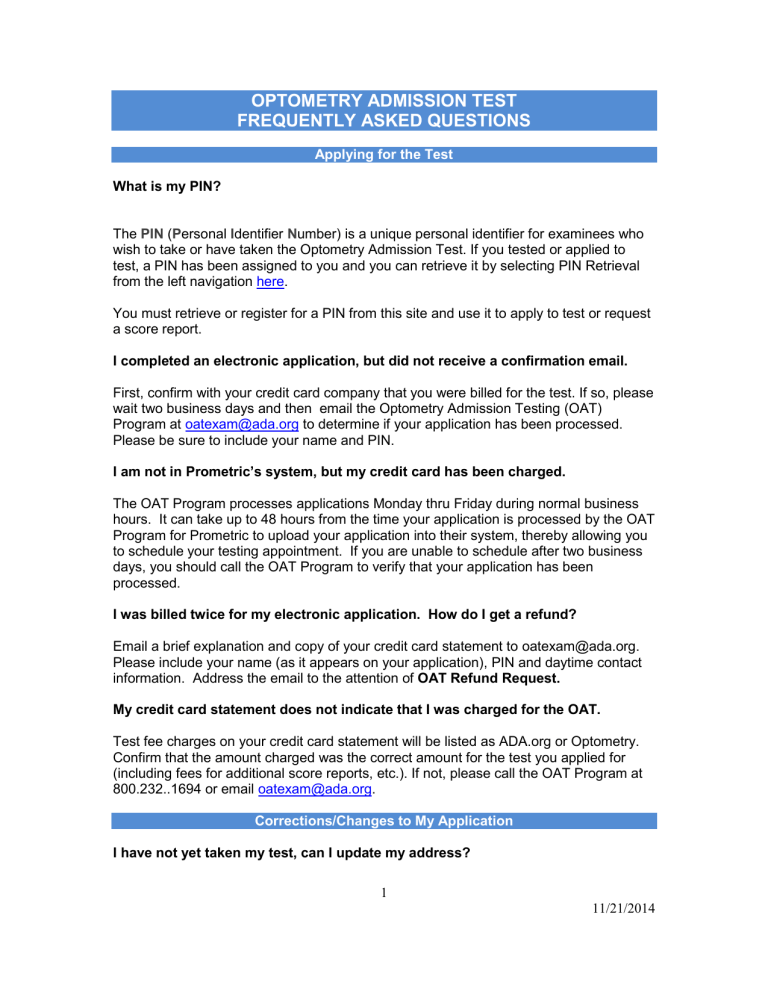
OPTOMETRY ADMISSION TEST
FREQUENTLY ASKED QUESTIONS
Applying for the Test
What is my PIN?
The PIN ( P ersonal I dentifier N umber) is a unique personal identifier for examinees who wish to take or have taken the Optometry Admission Test. If you tested or applied to test, a PIN has been assigned to you and you can retrieve it by selecting PIN Retrieval from the left navigation here .
You must retrieve or register for a PIN from this site and use it to apply to test or request a score report.
I completed an electronic application, but did not receive a confirmation email.
First, confirm with your credit card company that you were billed for the test. If so, please wait two business days and then email the Optometry Admission Testing (OAT)
Program at oatexam@ada.org
to determine if your application has been processed.
Please be sure to include your name and PIN.
I am not in Prometric’s system, but my credit card has been charged.
The OAT Program processes applications Monday thru Friday during normal business hours. It can take up to 48 hours from the time your application is processed by the OAT
Program for Prometric to upload your application into their system, thereby allowing you to schedule your testing appointment. If you are unable to schedule after two business days, you should call the OAT Program to verify that your application has been processed.
I was billed twice for my electronic application. How do I get a refund?
Email a brief explanation and copy of your credit card statement to oatexam@ada.org.
Please include your name (as it appears on your application), PIN and daytime contact information. Address the email to the attention of OAT Refund Request.
My credit card statement does not indicate that I was charged for the OAT.
Test fee charges on your credit card statement will be listed as ADA.org or Optometry.
Confirm that the amount charged was the correct amount for the test you applied for
(including fees for additional score reports, etc.). If not, please call the OAT Program at
800.232..1694 or email oatexam@ada.org
.
Corrections/Changes to My Application
I have not yet taken my test, can I update my address?
1
11/21/2014
Go to http://www.ada.org/en/oat/pin and click on the Update Your Pin quick link on the upper left hand side. Once you log in, you may make your changes there. Your information will be updated in OAT Program system the same day.
My name is reversed or my name has changed. Can you correct it?
Using the PIN Request Form, submit the request for a name change (must be received prior to your testing appointment) by email to pin@ada.org
with appropriate documentation such as marriage certificate or court documents.
If your name is reversed, please send a copy of your government issued ID only.
General Information
What is on the test?
The OAT consists of multiple-choice items distributed across a battery of four tests: the
Survey of the Natural Sciences (Biology, General Chemistry, and Organic Chemistry),
Reading Comprehension, Physics, and Quantitative Reasoning Tests. The test specifications list the topic areas covered in each of the four tests and are located in the
OAT Guide at www.ada.org/oat;please review for detailed information.
How long does the test take?
Please refer to the OAT Guide for detailed information on the administration of the test: www.ada.org/oat
Optometry Admission Test
Optional Tutorial
Survey of Natural Sciences
Reading Comprehension Test
Optional scheduled break
Physics Test
15 minutes
90 minutes
50 minutes
15 minutes
50 minutes
Quantitative Reasoning Test
Optional Post-Test Survey
Total Time
45 minutes
15 minutes
280 minutes
Where can I find study materials?
Test Specifications can be found in the OAT Guide located at: www.ada.org/oat .
Test preparation materials and a sample test are located on the same site. This is the only sample test that is available. In addition, on the same site, there is a tutorial designed to familiarize examinees with the format of the questions.
Examinees are cautioned that obtaining or sharing confidential, unreleased test content violates Examination Regulations and carries significant penalties. Further, material obtained from sources such as Internet chat rooms, blogs or information-sharing sites may be inaccurate and/or out-dated and could mislead or disadvantage test-takers.
2
11/21/2014
Retest
How long do I have to wait to retest?
You must wait 90 days between testing attempts.
Refunds
Are refunds available?
Test fees are non-refundable and non-transferable .
Scheduling a Testing Appointment
When is the OAT offered?
The OAT is administered by Prometric Test Centers in the United States, its territories
(Guam, Puerto Rico, and the Virgin Islands), and Canada. Testing appointments are available year-round.
How do I schedule a testing appointment with Prometric?
You will receive an email that contains instructions for scheduling your testing appointment after your application has been processed. If you do not receive an email, contact the OAT Program to verify that your application has been processed. You can schedule by contacting the Prometric Call Center at 800.688.5804 or at www.prometric.com
.
I called the Prometric 800 number, but I cannot get through. What can I do?
You can schedule electronically at www.prometric.com
. Otherwise, please call
Prometric when call volume is low. Call volume is higher on Mondays and Tuesdays and hold times are considerably less after Tuesdays. The Call Center is open from 8 a.m. to 8 p.m., Eastern Time, Monday through Friday.
Prometric says I am not in their system, what can I do?
If your application has been processed, and it has been more than two business days, please contact Prometric’s Candidate Care hotline at 800.853.6769.
Scoring/Score Reports
How is the test scored?
OAT scores are based on the number of correct responses. Please refer to the
OAT
Guide
at www.ada.org/oat for detailed scoring information.
3
11/21/2014
Is the OAT scored on a curve?
The OAT is not scored on a curve. OAT scores are reported in standard scores.
Standard scores provide normative information about knowledge or problem solving skills that examinees have demonstrated which allows a direct comparison of an examinee’s ability with other examinee’s abilities. Refer to the OAT Guide at www.ada.org/oat for specific details on OAT scoring.
When will I receive my score report?
Unofficial score reports, generated at the test center, are provided for the examinee upon completion of testing. Official score reports are available electronically to the schools requested on your application approximately three to four weeks after the test.
If I take the OAT and do not do as well as I would like, can I get my scores voided?
Once a n examinee has tested, those scores become a part of the examinee’s permanent record and cannot be voided.
How can I check to see which schools I requested to receive my scores?
When completing your OAT application or score report request, please print a copy of your confirmation page to ensure that you have a record of which schools you requested to receive score reports. There is no other method or opportunity available to confirm and/or review this information.
I have not tested yet; can I change the schools that I have requested on my OAT application?
The selection of 5 free schools for the OAT application are only free at the time of application. Once your application has been submitted to the Optometry Testing
Program, you cannot alter your school list on your application.
Requests for additional score reports must be submitted using the Score Report request link found at www.ada.org/en/oat . Additional fees apply to send reports to optometry schools not selected at the time of application (see the Testing Fees section of the OAT
Guide.
I have tested more than once; can I choose which scores are sent out?
You cannot choose to send any one particular set of scores. The scoring system reports the four most recent sets of scores.
How do I submit an electronic request for additional score reports?
You may use the electronic score request by visiting www.ada.org/oat . Score reports requested for alternate addresses are sent by standard U. S. mail.
Scores sent to any of the US or Canadian Optometry Schools are sent electronically to the schools within 3 business days of the request.
4
11/21/2014
Test Center Procedures
What constitutes proper identification for the test?
When you arrive at the Prometric Test Center to take the test, two original, current forms of identification (ID), one primary, and one secondary, will be requested and must be presented. The primary ID must be a government issued ID, with a photograph and a signature. Examples of acceptable primary IDs (with a photograph and signature) are a driver’s license, state ID card, or a passport/passport card. At least one ID must have both a picture and a signature. Examples of secondary ID (requiring only a signature) are a debit card, a library card, credit card, etc. Both forms of ID must be current (not expired).
The name on your primary and secondary IDs must match exactly with the name on your PIN. If the names on your IDs and PIN do not match exactly, you will be denied admission to testing, and you will forfeit your testing appointment and your application fee. You will be required to submit a new application and fee to test.
Name changes must be submitted in writing to pin@ada.org
at least two weeks prior to testing. If you have any questions concerning types of acceptable identification, please call the OAT™ Program at 800.232.1694.
What can I bring with me into the test center?
No personal or miscellaneous items are permitted in the secure testing area. Any personal belongings brought to the test center must be stored in a designated locker.
Storage facilities are limited. Upon reasonable suspicion, your personal belongings may be inspected. Notes or any materials accessed during testing or an unscheduled break that appears to contain test content may be confiscated. Accessing personal belongings during an unscheduled break violates Examination Regulations.
Items that are prohibited from the secure testing area include, but are not limited to the following: a. Books, notes, study materials, scratch paper, tissues, or markers not furnished by the testing center. b. Slide rules, paper, calculating devices, rulers or other measuring devices (a calculator will be provided on the computer screen during the Quantitative
Reasoning Test). c. Electronic devices, such as cell phones, recording devices, iPods, tablets, and personal earplugs or headphones/headsets. d. Tote bags; purses, wallets, backpacks, briefcases. e. Highlighters, pens, erasers, mechanical pencils, dictionaries and translators. f. Food, candy, gum, water or other beverages. g. Outerwear, such as coats, jackets, gloves, head coverings (except for religious or cultural purposes). h. Good luck charms, statues, religious or superstitious talismans. i. Medicinal items (except as approved in advance under testing accommodations).
5
11/21/2014
j. Watches (digital or analog) or timing devices (a timer is provided on the computer screen during testing). k. Magnifying devices
Violations may result in the voiding of your test scores and waiting up to two years to retest. Please refer to the OAT Guide for more specific information.
The OAT™ Program reserves the right to withhold, void or invalidate any score when, in our judgment, there is a good-faith basis to question the validity of the scores for any reason. Cause for withholding, voiding or invalidating scores may include, but not limited to:
Unusual answer patterns
Atypical score increases from one test to another
Inconsistent performance on different parts of the test
A test administration irregularity
A discrepancy in, or falsification of, an examinee’s identification
Information indicating that an examinee has engaged in misconduct or violation of the rules and regulations
Falsification of the examinee’s score report
Any other information indicating the results may not be valid
Falsification of application or supportive documents
If it is determined that an examinee engaged in irregular behavior, information regarding this determination becomes a part of the examinee’s OAT record. In its sole discretion, the OAT Program may elect to send a summary report documenting the incident, with a brief statement provided by the examinee immediately following the decision by the OAT Program to report, to legitimately interested parties, including all persons or agencies to which the examinee has instructed that scores be sent, both presently and in the future.
Testing Accommodations
I require accommodations for testing, what do I need to do to receive accommodations?
If you have a documented disability recognized under the Americans with Disabilities Act and require testing accommodations, you must:
1. At the time you submit your OAT™ application and prior to scheduling a testing appointment, select ‘Yes’ that you are requesting testing accommodations. You must submit an application to test and the testing accommodation request form and the supporting documentation. The process is not complete until you have submitted all three components. You will schedule a testing appointment after your testing accommodation request has been approved. Testing accommodations cannot be added to existing appointments. If you schedule a test date before the approval of testing accommodations, you will be required to cancel the appointment and pay a fee.
6
11/21/2014
2. Submit the following (scanned) documents to testingaccommodations@ada.org
: a. Testing Accommodation Request Form (PDF) (found under Apply to Take the
OAT ) signed, and dated, describing the disability and the need for accommodations. Accommodations should align with the identified functional limitation so that the adjustment to the testing procedure is applicable to the identified impairment. A functional limitation is defined as the behavioral manifestation of the disability that impedes the individual’s ability to function. b. Current evaluation report (within the past five years) from the appropriate professional. The document (must be on official letterhead/stationary) should include the professional’s credentials, signature, address, and telephone number. The report must indicate the examinee’s name, date of birth, and date of evaluation. The report should include:
1. The specific diagnostic procedures or tests administered.
Diagnostic methods used should be appropriate to the disability and in alignment with current professional protocol.
2. The results of the diagnostic procedures and/or tests and a comprehensive interpretation of the results.
3. The specific diagnosis of the disability , with an accompanying description of the examinee’s limitations due to the disability.
4. A summary of the complete evaluation with recommendations for the specific accommodations and how they will reduce the impact of identified functional limitation. c. Documentation of any previous accommodations provided by educational institutions or other testing agencies. If no prior accommodations were provided, the professional should include a detailed explanation as to why no accommodations were given in the past and why accommodations are needed now.
7
11/21/2014
